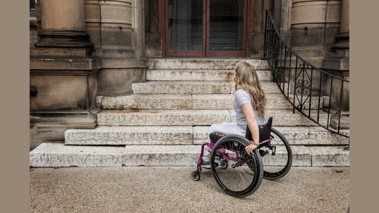Women Aging with Spinal Cord Injury Part 1 - Reeve Foundation
First thing each morning, 73-year-old Jane Buchan takes the medication that helps manage her ever-increasing neuropathic pain. Its effects last a few hours, so Buchan —who lives with a T7 spinal cord injury – uses the time to get dressed, feed her dogs and sometimes work in the garden. But by early afternoon, the pain is back.
"The only way I can get relief is to go lay down for a couple hours,” she says. “Sometimes its three or four. A lot of time is wasted during the day. A lot doesn’t get done because I don’t have the energy.”
Chronic pain is among the many secondary conditions, including cardiovascular disease, muscle and bone deterioration, and kidney and bladder stones, that men and women aging with spinal cord injuries develop earlier and more frequently than the general population. But women, who comprise roughly 20 percent of individuals living with injuries, face a unique set of physical and emotional challenges, from fatigue and pain management to bowel and bladder issues to the wide-ranging effects of menopause.
“Menopause is the biggest game changer for women as they age,” says Maggie McNiece, an inpatient therapy manager for the spinal cord injury unit at Kessler Institute for Rehabilitation. “That experience is compounded by the effects of spinal cord injury.”
The reduced estrogen production that occurs with menopause can cause decreased muscle mass and weight gain, and fluctuations in blood sugar levels impacting diabetes management or urinary tract infections. It also significantly increases the risk for fractures in women with spinal cord injuries who are already predisposed to osteoporosis due to the loss of bone density that occurs immediately after injury.
Buchan, who began menopause when she was 45, discovered she was on the cusp of developing osteoporosis near her 60th birthday; she broke her leg three years later.
“I was sitting in a chair and had one leg crossed over the other,” she says. “I bent over to pick up something and I heard a pop. It was my femur.”
Over the next decade, as her energy level and strength declined, Buchan switched to a power wheelchair, helping to slow down damage to her arms from overuse and allowing her to continue gardening.
Recognizing and adapting to the realities of aging is critical, says McNiece. Equipment and lifestyle modifications can help mitigate age-related challenges. Sitting positions, transfer techniques, and bowel and bladder management programs can be adjusted to deal with increased pain and prevent additional secondary health conditions from developing. A different sized catheter might help address increasing incontinence. Switching from a manual to a power wheelchair can help preserve upper limb function and prevent weakened or damaged muscles from causing falls during transfers.
“Women need to take charge of their own health,” McNiece says. “This is not a time to be passive. A lack of familiarity with spinal cord injuries already creates challenges to effective preventative care. Really just being an advocate for yourself is key.”
McNiece recommends that women understand the symptoms of aging and begin monitoring their bodies long before there is a crisis, including: examining skin regularly for wounds and to better notice as it thins with age; tracking and understanding the triggers and changing symptoms of urinary tract infections; and exercising to maintain cardiovascular health.
Women should periodically visit a physiatrist, or physical or occupational therapist, to map age-related challenges and assess functionality in order to preserve as much independence as possible. But eventually, aging will likely require larger changes to lifestyle or longtime routines.
Jane Buchan has lived independently since sustaining her injury during a horseback riding accident in 1992, but lately, as her pain increases and strength declines, she’s begun to worry about how much longer she can remain on her own. Her son, who lives 250 miles away, would like her to move in with his family. She’s not quite ready, but the question is ever-present.
“I ask myself every day what I’m going to do if something happens and I can’t get out of bed on my own,” she says.
Join Our Movement
What started as an idea has become a national movement. With your support, we can influence policy and inspire lasting change.
Become an Advocate